Sudan
Basics of Kushite Religion
The Story of Creation, Jebel Barkal, and Maat
The Story of Creation:
According to Kushite (Nubian) beliefs, before creation, the world was all covered with water. Then a mound of earth
has risen out of the water. On top of this mound, Atum the first god on earth, was born. Atum then gave birth to
Shu, the first man on earth, and Tefnut, the first woman goddess. Shu and Tefnu married and gave birth to
Geb (God of Earth) and Nut (God of the Skies).
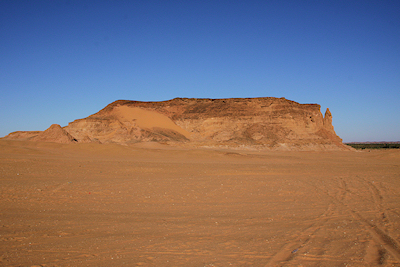
Jebel Barkal
Geb and Nut then were responsible for giving birth to the most important gods in Nubia, Osiris (God of the
Pharaohs) and Seth (God of Devastation), and Isis (God of Motherhood) and Nephthys (Protector of
the Dead).
Atum signified the concept of creation. Atum was also believed to have created the heavens and earth. He was portrayed
as an old man and sometimes with a ram head in connection to Amon.
Re was the most publicly worshiped form of Atum, though the cult of Re emerged as a universal god. The symbol of Re is
a sun disk, which is found to be pictured on chapels of pyramids as well as on temples.
Jebel Barkal:
Jebel-Barkal (in Arabic meaning the Holly Mountain), in Napata (capital of Kush), Sudan. Both the Kushites and Egyptians believed that Jebel-Barkal was the site where life on earth had started. Thus, this mountain functioned, throughout history, as the center of religious life in Nubia. There, numerous temples had been constructed, including the Amon temple where the major religious ceremonies took place and the annotation of pharaohs. During religious festivals, these temples would have gotten crowded with pilgrims who traveled from distant places to pay homage to the Nubian deities.
Maat:
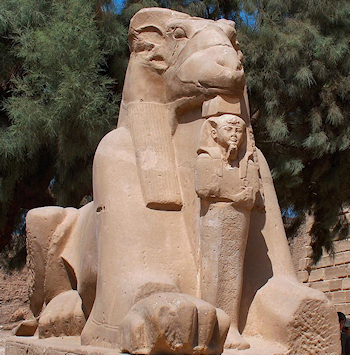
Amon-Re
represented by a ram in front of his temple
Maat is the concept of order and righteousness that was required of rulers to adhere to, and judge by. The concept
shaped Kushite politics and played a role similar to the constitution. According to Maat, however, the priests had the
right to decide whether a king was ruling properly or not. If they decided that a ruler was inconsistent with the Maat
doctrine, they could process an order that he or she commit a suicide.
The system of Maat, however, had also helped to preserve a sense of order and morality among common people. Opposite
to meaning of Maat was the function of God Seth, who was believed to cause disorder and challenge immoral
behavior and ignite evil acts. Yet, dealing with him in the religious rituals, the Seth had an important role to play
accomplishing the function of Maat. This concept remained the main doctrine in Nubia throughout its pagan history.
Amon:
Material items found at the Deffufa temple in Kerma (built around 1600 BC) are considered revolutionary in helping
to understand the origins of Kushite belief systems. There, statues of Amon, the ram-headed the creator god, were
clearly labeled and sculptured. At a later date, this cult was worshiped in Thebes and became the most prominent god
in ancient Egypt.
Throughout the history of Nubia, Amon remained the chief deity, which greatly shaped the order in which the Kushite
pharaohs ruled. One inscription states that King Tanwetamany attacked the Assyrians in Lower Egypt as a response
to a vision that he saw in sleep that Amon assured his success. Again, when Tanwetamani withdrew his forces from Lower
Egypt, Herodotus tells us that the King's action was a result of a dream, in which God Amon told him to
withdraw.
The Nubians believed that the priests had their spiritual ways to communicate with God Amon in order to consult with
him on the election of the righteous king from among the candidate family members. At Amon Temple in Napata, in front
of the cult of Amon in the holly sanctuary of the temple, the chosen Kushite king was anointed and declared pharaoh.
The Funerary Scene
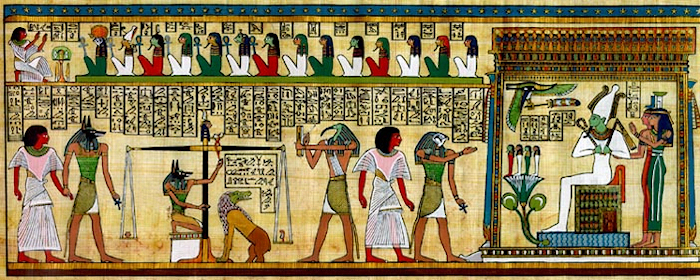
In the Hall of Two Truths, the deceased's heart was weighed against the Shu feather of truth and justice taken
from the headdress of the goddess Ma'at. If the heart was lighter than the feather, they could pass on, but if it were
heavier they would be devoured by the demon Ammut. This scene depicts what occurs after a person has died, according to
the ancient Egyptians.
Beginning with the upper left-hand corner, the deceased appears before a panel of 14 judges to make an accounting for
his deeds during life. The ankh, the key of life, appears in the hands of some of the judges.
Next, below, the jackal god Anubis who represents the underworld and mummification leads the deceased before
the scale. In his hand, Anubis holds the ankh.
Anubis then weighs the heart of the deceased (left tray) against the feather of Ma'at, goddess of truth and justice
(right tray). In some drawings, the full goddess Ma'at, not just her feather, is shown seated on the tray. Note that
Ma'at's head, crowned by the feather, also appears atop the fulcrum of the scale. If the heart of the deceased outweighs
the feather, then the deceased has a heart which has been made heavy with evil deeds. In that event, Ammut the
god with the crocodile head and hippopotamus legs will devour the heart, condemning the deceased to oblivion for
eternity. But if the feather outweighs the heart, and then the deceased has led a righteous life and may be presented
before Osiris> to join the afterlife. Thoth, the ibis-headed god of wisdom stands at the ready to record
the outcome.
Horus, the god with the falcon head, then leads the deceased to Osiris. Note the ankh in Horus' hand. Horus
represents the personification of the Pharaoh during life, and his father Osiris represents the personification of the
Pharaoh after death.
Osiris, lord of the underworld, sits on his throne, represented as a mummy. He holds the symbols of Egyptian
kingship in his hands: the shepherd's crook to symbolize his role as shepherd of mankind, and the flail, to
represent his ability to separate the wheat from the chaff. Behind him stand his wife Isis and her sister
Nephthys. Isis is the one in red, and Nephthys is the one in green. Together, Osiris, Isis, and Nephthys welcome
the deceased to the underworld.
Ancient Nubian gods
Atum:
In his representations, Atum took both a human form as well as a serpent. He is often seen wearing the double crown
and sitting on a throne. When represented as a serpent, this was in connection to his role in the creation of the world,
and with him being central in the future collapse of the cosmos. There were also other animal representations attributed
to Atum, but these are rare and not part of any systematic theology. The only exception to this was the scarab, and the
famous, giant scarab at Karnak, Luxor was dedicated to Atum.
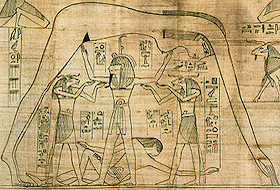
The air god Shu, assisted by other gods,
holds up Nut, the sky, as Geb, the earth, lies beneath.
Shu:
In Ancient Egyptian Religion, god of air, sunlight and bearer of heaven. His named meant "emptiness" or
"he who rises up."
Shu's role was to support his daughter Nut when she stretched out in her capacity as the sky. As the air, Shu
was considered to be cooling, and thus calming, influence, and pacifier. Due to the association with air, calm, and
thus Ma'at (truth, justice and order), Shu was portrayed in art as wearing an ostrich feather. Shu was seen with between
one and four feathers.
Tefnut:
Tefnut is a goddess of moisture, moist air, dew and rain in Ancient Egyptian religion. Tefnut is a leonine deity, and appears as human with a lioness head when depicted as part of the Great Ennead of Heliopolis. The other frequent depiction is as a lioness, but Tefnut can also be depicted as fully human.
Geb:
In Ancient Egyptian Religion, important male earth-god; this function was usually associated with female deities.
Geb is often depicted as lying by the feet of Shu and Nut above the two. Usually he was represented as
a man without distinguishing characteristics. In older times he was always presented in a human form, while a black
goose would eventually become his symbol.
Nut:
Nut was the goddess of the sky, more specifically the vault of the heavens. Often she was represented as a woman
arched over the earth, who was the god Geb. In other representations she wore a waterpot, and a vessel on her
head that was shaped as a pear. Other times she was represented as a cow, which was the shape she had when she carried
the sun god Re on her back, up to the heavens.
Nut swallowed the sun in the evening, and gave birth to him in the morning.
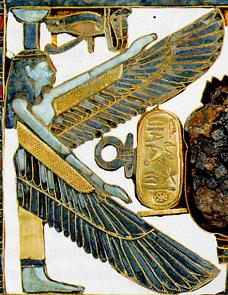
Nephthys;
Seth:
Seth is presented in many different ways, in most cases as a dog-like figure, but also as antelope, ass, camel,
fennec, jackal, mouse or pig.
In the myths, Seth undergoes an interesting development, which is strongly influenced by political incidents of Egypt.
At first Seth was a god of normal qualities, a god of the sky, the desert, protector against storms and of warfare.
But eventually negative qualities of Seth came to be accentuated, and more and more he was presented as a troublemaker.
Not only did he break his own way out of the womb of his mother, but he soon came to be the murderer of his brother
Osiris — thereby giving birth to the most famous of all Egyptian myths.
Nephthys:
Nephthys was a goddess with wide power and capacity, and she was often referred to as "The Useful Goddess."
She could also be dangerous, able to kill the enemies of the king with her fiery breath. In this capacity, she was
considered a protector of the king.
She was the sister of Isis; the two represented each their role with the beginning and end of earthly life,
Isis the birth and Nephthys the death. When appearing together with Isis, she is often represented as a kite, a falcon
or a woman with falcon wings.
Isis:
Isis was the goddess of fertility and motherhood, love and gaiety, moreover she had magical skills.
Central for the understanding of Isis' role is the story in which her husband, Osiris, is murdered. He was
killed by Seth, and Isis set out to search for his corpse, finding altogether 14 pieces of him at different
locations all around Egypt. She buried 13 of these pieces, except the phallus, with which she conceived Horus.
By Horus, Osiris was brought back from the dead.
Isis was represented as a woman, with the sign of throne on her head. Usually she was sitting on a throne, either
alone, or holding Horus, or she was kneeling in front of a coffin. Sometimes she was represented with a cow's head
with the solar disc between her two horns.
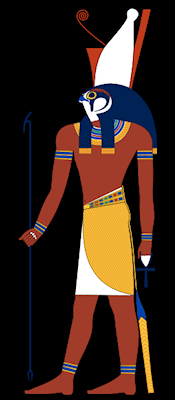
Horus,
god of war, sky, and protection
Osiris:
Osiris was a representative for the setting sun, he was the ruler of the dead and the resurrected king, as well as god of fertility. The apparent duality between being god of the dead and god of fertility, is best explained by the fact that many cultures through the history of religions have seen fertility as growing on the death of someone or something.
Anubis:
Anubis is represented either by a jackal, or by a man with the head of a jackal and with black skin. His head may
well resemble the head of the dog race, Pharaoh Hound.
He was in charge of the funerary cults, especially the embalming process, an act which he performed on Osiris. He was
also the judge of the dead, during which the Egyptians believed that he weighed the heart of the dead against the
feather of truth.
Ammut:
Ammit was a female demon in ancient Egyptian religion with a body that was part lion, hippopotamus and crocodile — The three largest "man-eating" animals known to ancient Egyptians. A funerary deity, her titles included "Devourer of the Dead", "Eater of Hearts", and "Great of Death".
Thoth:
Thoth was the god of the moon, and therefore the god who measured time. He was also the god of calculation,
writing, learning, wisdom, laws and magic. He was the god who invented writing and the languages. In the realm of
the gods he served the roles as the scribe, the interpreter, the advisor, and he could also be the representative of
Re.
Thoth was normally represented as a human with the head of an ibis, or as an ibis, or as a baboon with the head of a dog.
Horus:
In ancient Egyptian religion, God with his powers devoted to the sky, light and goodness. Horus was depicted as a
falcon, his left eye being the moon, and the right, the sun.
In the myth of Osiris, Horus was presented as his and Isis' son, as well as the opponent of Seth. In this
myth, Horus had to defeat Seth to become king of Egypt.
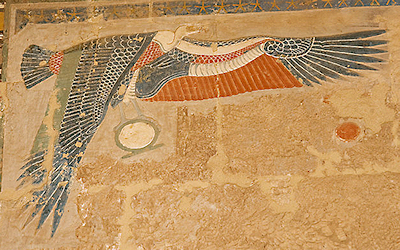
Nekhbet:
Apedemac:
Apedemac was supposed to resemble a lion with a human body. Since lions (as animals) symbolized the concept of power and strength, Apedemac was considered the war god of Nubia. The ancient Nubians believed that Apedemac brought victories to their armies and defeated their enemies. When Nubian pharaohs carried military campaigns, they often claimed the support and companionship of Apedemac.
Hapy:
The god of the annual Nile flooding and defined as husband of Wadjet in Lower Egypt, and Nekhbet
in Upper Egypt. The annual flooding in June was said to be the "Arrival of Hapy."
Hapy was usually represented as a bearded man with large, female breasts, a large belly and headdress of aquatic
plants. This symbolized fertility and regeneration.
Wadjet:
The cobra-goddess of mainly symbolic importance as patron goddess of Lower Egypt. As a protector goddess, she was often seen on the head of Re. It is from her that the Ureaeus symbol has come. She was also associated with the Eye of Re.
Nekhbet:
She gradually emerged as the personification of Upper Egypt, and was identified with the white crown. From this,
she became closely associated with the person of the king. She was his protector, and sometimes represented as the
mother of the king's divine aspect.
Her representation was a vulture with the wings spread out, holding the shen signs of eternity. This corresponded
with the Egyptian idea that vultures only existed as females.
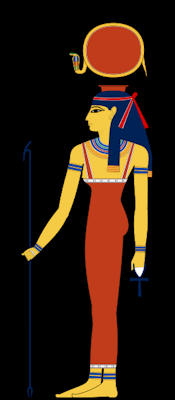
Hathor;
Goddess of sky, love, beauty
Khnum:
In the creation myths of Khnum it is expressed how human beings were created on a potter's wheel. Khnum was also the donor of the Nile waters. He was usually represented in the form of a human with a ram's head.
Dedwen:
Dedwen, God of Wealth and Incense. He is associated with the Southern Lands. Dedwen is usually depicted in human
form but also as a lion.
In the Pyramid Texts the king is honored as Dedwen lord of Nubia. The royal aroma is that of the incense brought by
Dedwen for the gods. The connection with the pharaohs is also seen in the fact that Dedwen burns incense at royal births.
Eye of Re:
This Goddess was depicted as a uraeus, and was sometimes accompanied with a disk-shape. The Kushites believed that the Eye of Re watched and protected the pharaoh from enemies by spitting flames on them.
Sebiumeker:
Although Sebiumeker was a major god in Sudan, historians do not have a lot of information about how the Kushites perceived him. Since representations of this god are often located near doorways, he is thought to have been some sort of a guardian God.
Hathor:
Hathor is one of the most famous goddesses of Ancient Egypt. She was known as "the Great One of Many Names" and her titles and attributes are so numerous that she was important in every area of the life and death of the ancient Egyptians.
Bes:
Bes was a local God in ancient Sudan. This god was thought to protect from evil spirits and bring good luck. Representations of
Bes were uncovered in numerous numbers from ordinary and rich graves alike, throughout Sudan.
The cult of Bes was associated with pregnancy and the health conditions of newborns. For that reason, Bes was particularly popular
among women.